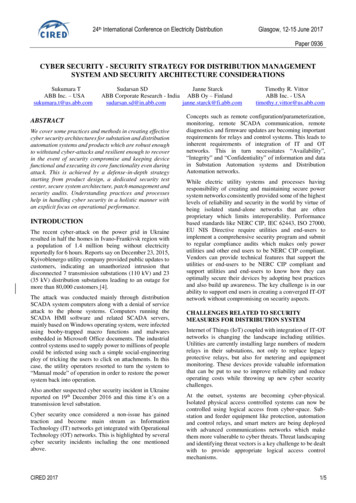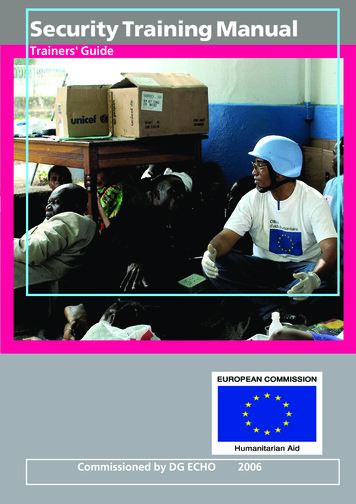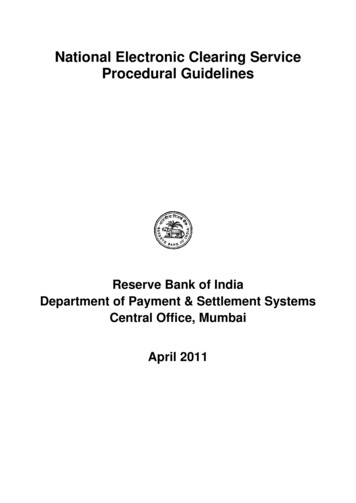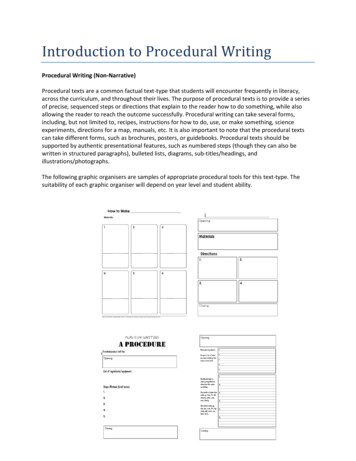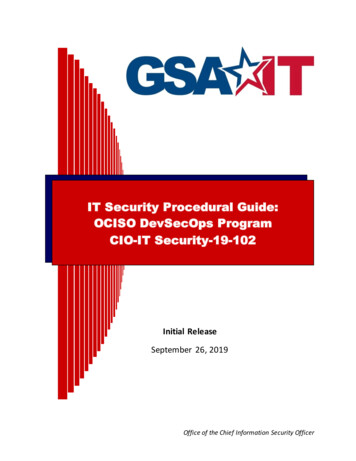
Transcription
IT Security Procedural Guide:OCISO DevSecOps ProgramCIO-IT Security-19-102Initial ReleaseSeptember 26, 2019Office of the Chief Information Security Officer
CIO-IT Security-19-102, Initial ReleaseOCISO DevSecOps ProgramVERSION HISTORY/CHANGE RECORDPersonPostingChangeChangeNumberChangeInitial Release – September 26, 2019N/AISENew guide created to integratesecurity into DevOps teams.U.S. General Services AdministrationReason for ChangePageNumber ofChange
CIO-IT Security-19-102, Initial ReleaseOCISO DevSecOps ProgramApprovalIT Security Procedural Guide: OCISO DevSecOps Program, CIO-IT Security-19-102, Initial Releaseis hereby approved for distribution.Xe-Signed by Bo Berlason 2019-09-27Bo BerlasGSA Chief Information Security OfficerFor questions concerning the DevSecOps Program contact: GSA Office of the ChiefInformation Security Officer (OCISO), Security Engineering Division (ISE), at ocisodevsecops@gsa.govFor questions concerning GSA Policy and Compliance contact: GSA Office of the ChiefInformation Security Officer (OCISO), Policy and Compliance Division (ISP), atispcompliance@gsa.gov.U.S. General Services Administration
CIO-IT Security-19-102, Initial Release12Table of ContentsIntroduction . 1Purpose. 12.12.22.32.434OCISO DevSecOps ProgramImprove Security and Quality . 1Facilitate a cultural shift. 1Reduce silos and communication barriers. 1Provide security services through an integrated engineer. 1Scope . 2Defining DevSecOps . 24.1 What DevSecOps Is Not . 34.2 What DevSecOps Is . 35ODP Governance Model . 35.1 Roles and Responsibilities. 35.1.1 ODP Security/DevSecOps Engineer. 45.1.2 DevSecOps Application Team . 55.1.3 System Owner . 55.1.4 ODP Team . 65.1.5 Chief Information Security Officer . 65.2 Overview of Processes and Procedures . 75.3 Communication, Report, and Organizational structure . 75.4 IT Security Metrics . 96Operational Model . 116.1 People . 126.2 Processes. 126.3 Technology . 137Prerequisites for Initial Integrations . 137.17.27.37.47.5Uses a Platform . 13Uses a Continuous Integration and Continuous Deployment (CI/CD) Pipeline. 14Uses Automation. 14Leverages a Robust API . 14Commitment to Abide by the Operational Model. 148 How to Initiate an ODP DevSecOps Integration. 149 Rules of ODP DevSecOps Engagement . 1410 ODP Resources / Links . 15Figure 5-1. OCISO DevSecOps Governance Model. 3Figure 5-2. Security Engineer Communication and Reporting . 8Table 5-1 - Key Security Control/Capability Gaps . 9U.S. General Services Administrationi
CIO-IT Security-19-102, Initial Release1OCISO DevSecOps ProgramIntroductionWith more teams at the General Services Administration (GSA) leveraging Development andOperations (DevOps) practices, ensuring effective security practices has become paramount.The Office of the Chief Information Security Officer’s (OCISO) DevSecOps Program (ODP) aimsto ensure that GSA teams who practice DevOps adopt security forward thinking. The programfacilitates the creation and operation of DevSecOps teams in GSA.2PurposeThis guide serves to establish the ODP throughout GSA’s development, operations, and securityorganizations. The program establishes security as the third component into the DevOps teams,effectively creating DevSecOps teams in GSA. The ODP will be managed and run by OCISOSecurity Engineering (ISE) division. This procedural guide will establish a process and operatingprinciples for ODP. The following subsections define program goals.2.1 Improve Security and QualityThe ODP aims to ensure security is considered and implemented in all design and operationalphases. The ODP aims to provide full security support in areas including Incidence Response,Security Automation, and Compliance.2.2 Facilitate a cultural shiftSecurity is often associated with compliance at GSA. While an important part of the system lifecycle, security is not just compliance. The ODP aims to shift the agencies thinking of justAuthorization to Operate (ATO)’s and Compliance to everyday considerations and operations.The ODP is intended to have everyone adopt a “How can we do this securely?” mindset.Furthermore, we aim to shift the thinking of “security as engineers over there” to they are partof our team.2.3 Reduce silos and communication barriersToo often, the OCISO DevSecOps programs only engagement with system teams occurs whenthere is an incident or when there is an assessment. The lack of sharing information and codeleads to “rebuilding the wheel” development cycles. The ODP aims to provide a simple andconsistent communication channel where solutions, code, and more can be shared amongstteams to make development cycles efficient and secure.2.4 Provide security services through an integrated engineerMost often OCISO security services are only available during Assessment & Authorization(A&A), Incident Response and in support of limited ISSO functions. Security services areprovided through different divisions and teams. By placing an integrated security engineer inthe DevSecOps team, the OCISO DevSecOps program can deliver all security services throughU.S. General Services Administration1
CIO-IT Security-19-102, Initial ReleaseOCISO DevSecOps Programthe integrated engineer. The integrated engineer could be your ISSO and can provide servicesfor ODP security-related functions.In addition to the program goals, this document will define the following areas: Defining DevSecOpso What does DevSecOps mean and how does the ODP define it? Prerequisiteso What are the requirements for your team to successfully integrate with the ODP Governanceo What are the governing principles of the ODP?o Items such as: Roles and Responsibilities Policy and Procedure Communication, Report, and Organizational structure Metrics Operational modelo What are the guidelines and guardrails of the program?3ScopeThe OCISO DevSecOps Program is available to all GSA cloud-based information systems. TheODP resources and services may consist of security guidance, providing DevSecOpscode/documentation/reference architecture, and/or integrating a security engineer into yourteam.4Defining DevSecOpsDevSecOps is an iteration of the term DevOps. DevOps originates from the idea of combiningtwo previously siloed groups, Development and Operations. Then by using practices, tools, anda new cultural approach, teams can build and deliver applications and/or services at greatlyincreased speed and at scale. DevSecOps makes security an equal partner in the workflow.As with DevOps, DevSecOps can have different definitions depending on the industry or systemowner. It can range from “simple cross-functional collaborative team including IT securitypersonnel” to “Self-sustained, highly agile, self-managed team driving cultural shift”. While thisdocument will not establish a universal definition of DevSecOps, it will define how the ODPdefines it.At a high level, the ODP defines DevSecOps as “Integrating security into all the workflows andpractices of DevOps.” Or as DevSecOps.org’s statement reads “everyone is responsible forsecurity” Due to the complexity and nuance of DevSecOps, the following sections expand ondefining what it is and what it is not.U.S. General Services Administration2
CIO-IT Security-19-102, Initial ReleaseOCISO DevSecOps Program4.1 What DevSecOps Is Not A set of security toolsSolely automating a security functionSolely security compliance4.2 What DevSecOps Is 5Embracing a culture where everyone is responsible for the securityConsidering security in all aspects of the system life cycle. From the first system kickoffto the final decommissioning.Using the already existing DevOps practices and methodologies to implement, enforce,and monitor security.Implementing paved roads. Paved Roads include items such as pre-approvedarchitectures, processes, capabilities, solutions, etc. that wouldn’t need additionalreview or approvals.ODP Governance ModelThe ODP governance model consists of four major areas. Each area sets foundational principlesto be followed by each stakeholder. To adopt an agile culture of DevSecOps, these foundationalgoverning principals and their details can be revisited for each engagement and will be finalizedas a mutually agreed set of principles/ROE between OCISO and integrated teams.Figure 5-1. OCISO DevSecOps Governance Model5.1 Roles and ResponsibilitiesWell defined roles and responsibilities are imperative for cross-functional DevSecOps teams.Teams desiring integration with the OCISO DevSecOps program shall adhere by these high-levelU.S. General Services Administration3
CIO-IT Security-19-102, Initial ReleaseOCISO DevSecOps Programroles and responsibilities. However, to support agility and based on the maturity of the team,these roles and responsibilities will be reviewed prior to each engagement. Mutually agreedupon roles and responsibilities will be finalized between the ODP program and the integratedDevSecOps teams.The ODP integrated engineer’s priority is security focused on technical design andimplementations. The ODP program is designed to provide an integrated working model in acollaborative way with GSA DevOps teams. The ODP program will NOT change any complianceor ATO related to existing security policy and procedural guidelines/practices. However, ODPwill encourage and adhere to any changes in the future.The ODP program intends to keep compliance and operational security domains separate tocreate a more collaborative working environment between the integrated engineer andDevSecOps teams. It is the system owner’s responsibility to maintain a level of separationbetween security design, engineering, operations, and compliance related activities. The ODPprogram establishes a collaborative working environment by integrating SecDevOps securityengineers into the development teams ensuring security becomes a part of DevOps practices.5.1.1 ODP Security/DevSecOps EngineerThe ODP Security/DevSecOps Engineer serves as the overall Security SME/Champion for theassigned system. (The engineer assigned to this role could also be designated as the traditionalISSO, upon agreement between ODP and integrated team.)Responsibilities: Works with the system team on all aspects of system security in collaboration with theDevSecOps team which includes security designs, security architecture, implementation,operations, and compliance.Engages directly with integrated DevSecOps team in solution design, sprint planning,story creation, defining acceptance criteria, and to ensure security requirements areproperly addressed in early phases.Interprets security requirements, policy, standards, control statements and itsapplicability for DevSecOps team and/or system implementation.Acts as liaison between the security organization and divisions as needed.Engages directly with ODP for security-related questions, clarification, decision points,reviews, etc., as needed.Establishes a process to identify which changes need security review and approvals.Integrates into change management process as security reviewer.Collaborates with system team for security code review, compliance impact analysis,liaison with OCISO for security approvals.Establishes and maintains a security-related operating procedure for DevSecOps teamssuch as rapid risk assessment procedure, a procedure for engaging GSA IR team, etc.Provides support, code and consulting for integration with security tools and services.U.S. General Services Administration4
CIO-IT Security-19-102, Initial Release OCISO DevSecOps ProgramActively engages in operational security by solution, coding and/or code review, initialinvestigation on alerts and incidents, vulnerability identification and mitigation asneeded in collaboration with DevSecOps team.Collaborates with the System Owner for developing and maintaining the SystemSecurity Plan (SSP) and Plan of Action & Milestones (POA&M).Collaborates with other DevSecOps teams and security champions to build reusablesecurity code components, collaboration to build code library, security automation,security checklist, do’s/don’ts, security wiki, etc.5.1.2 DevSecOps Application TeamThe DevSecOps Application Team (team includes integrated security engineer) provides the dayto day operations of all the aspects of the system and/or application. It includes development,security, and operations. The DevSecOps Application Team could have different SME within theteam, but overall the team always owns all aspects of the system and/or application includingsecurity and compliance.Responsibilities: Everything for their system/application. That is designing, development, coding,operation, security, compliance, documentation, etc. based on business objectives andmission. Security design, implementation, alerts and incident monitoring, securitydocumentation and compliance. Adopting an operational model, which supports continuous releases, upgrade andchanges while fully maintaining security posture, principle, and compliances of theapplication/system. Develops standard operation procedure for security monitoring, investigating alerts takecorrective action and/or engage incident response team as needed.5.1.3 System OwnerThe system owner provides overall ownership of a system/product/application includingsecurity and compliance.Responsibilities: Provides clear product vision and roadmaps. Provides high level product requirements, design/architecture consideration, anddesign/operational decisions. Sets priorities, manages DevSecOps team, time, and resources. Manages task and priorities of security engineer for allocated time on each sprint cycle. Manages the onboarding, integration, and establishment of a working model foreffective collaboration between security engineer and existing DevOps team. Ensures ODP integrated engineer’s priority is security focused design, engineering,operation, and implementation. Resolves priority conflict between security/compliance requirements and applicationrelease/development priorities.U.S. General Services Administration5
CIO-IT Security-19-102, Initial Release OCISO DevSecOps ProgramMeasures and monitor program success against established/agreed metricscontinuously.Develops a plan and executed security requirements, checklist, guardrails, policy, andprocedure agreed as part of this integration.Collaborates with OCISO leadership (e.g., CISO, OCISO Directors, ISSM), along withintegrated security engineer for high-level decision making, review, and approvals asneeded. (Especially when such decisions are outside of established standards).5.1.4 ODP TeamThe ODP Team provides authoritative decisions to DevSecOps teams on questions, guidelines ,and reviews. The ODP Team acts as a security advisor, provides day to day support and acollaborative platform for all security engineers, DevSecOps engineers, and security champions.Responsibilities: Runs collaborative platform, scrum, Trello, question/clarification rosters to supportintegrated team, security engineer and security champions. Develops and maintains DevSecOps security checklists, wiki, implementation guides, andprocesses and procedures. Provides authoritative guides, decisions, and approvals for questions and requests,received by security engineer, security champions and/or integrated DevSecOps teams . Build repetitive decision-making processes and guidelines to empower security engineerand security champions. Works closely with CISO and/or CISO designee for authoritative decision making, whenthe team needs additional guidance. Works closely with CISO and/or CISO designee for A&A related assessment and finalsign-off. Works with other OCISO divisions as needed.5.1.5 Chief Information Security OfficerThe Chief Information Security Officer provides implementation and maintenance of the ITsecurity program, including the ODP. The Chief Information Security Officer also provides a finalauthoritative decision on all questions, concerns, and guidelines requested by the ODP.Responsibilities: Designates role or personnel to provide authoritative decisions, approvals, andguidelines for questions, concerns, approvals, and reviews requested by securityengineer, security champions and integrated DevSecOps teams. Provides final authoritative decision on all questions, concerns, and guidelinesrequested by the ODP team, security engineers, and security champions. Provides risk-based decisions and ATO sign-off for integrated DevSecOps teamsystems/applications, as per existing policy and procedural guidelines.U.S. General Services Administration6
CIO-IT Security-19-102, Initial ReleaseOCISO DevSecOps Program5.2 Overview of Processes and ProceduresThe ODP will identify the processes, procedures, and technical guidelines that stakeholdersshall adhere to. Initially, the ODP will propose core processes and procedures. As the teamintegrates and matures, the core processes and procedures will be refined and enhanced toprovide improved support to the teams.Processes, procedures, and technical guidelines that will be developed include: Standard security architecture and implementation guides for different platformsavailable for GSA teams. Pre-approved standard architecture and processes (paved road vs slow road). Checklists for security guard rails. Checklists for security implementation through a CI/CD pipeline. Processes for rapid threat/risk assessment. Security review processes for change management/production release. Processes for monitoring security events and engaging the IS incident response team. Process for incident response playbook testing and live fire exercises . Process for reviewing documentation, reviewing, and publishing security codecomponents (for facilitating code sharing between teams). Process for documenting security engineering decisions and precedence. DevSecOps change management and review process.Listed below are current lists of ODP approved processes, procedures and/or checklists forintegrated DevSecOps teams:ODP Security Checklist For AWS V1 :o Basic security checklist for ODP integrated teams using an Amazon CloudEnvironment.5.3 Communication, Report, and Organizational structureThe ODP is a cross-functional program, which demands cross-team collaboration,communication, and organizational structure. Integrated ODP Security/DevSecOps Engineer orsecurity champions will play a cross-functional role as outlined below.Shall report/communicate to product/system owner for: Day to day tasks tracked in Trello, sprint-based goals/progress, and project backloggrooming status. Tasks that shall be allocated based on agreed rules of engagement and percentage ofwork hours assigned for the engagement. Results from Internal security review, change/code review, security design review,vulnerability findings, remediation, etc. Status of security-related questions, feedback, reviews which needs support from otherOCISO resources and divisions.U.S. General Services Administration7
CIO-IT Security-19-102, Initial Release OCISO DevSecOps ProgramItems blocked or on hold.Shall report/communicate to the ODP for: Security-related initiatives, implementation status of security checklist, guardrails,compliance, vulnerability, etc. Integration of security tools and processes. Any incident and related investigations. Any sprint blocker that is directly related to pending action on any OCISO division. Results of agreed security metrics. Compliance status, issues, findings, and POA&M. Questions or clarifications related to security engineering, design, and compliance.Figure 5-1. Security Engineer Communication and ReportingU.S. General Services Administration8
CIO-IT Security-19-102, Initial ReleaseOCISO DevSecOps Program5.4 IT Security MetricsThe ODP will work with the teams to identify and track a set of metrics to measure programsuccess. This allows the teams to report to leadership (both from the application team and fromOCISO) with data and artifacts as evidence of the overall success of the integration.Furthermore, these metrics will be used by the ODP internally to measure effectiveness andareas for program improvement. Metrics might vary for different integrations based on theproject, application, and other factors.The final set of selected metrics for each integration should be clearly understandable andmeasurable in quantitative values or in checklist format (yes/no), and agreed to by ODP andapplication team management. See below for a list of examples to prompt discussions forestablishing metrics.Table 5-1 - Key Security Control/Capability GapsKey Security Control/Capability GapsMetricDescriptionHow to measure?Multi-FactorAuthentication(MFA)All authentication points use MFA forauthentication as per NIST 800-63-B.Checklist(Yes/No/NA)Data encryptionAll sensitive data (PII, PCI, authenticator orclassified as sensitive by business) is encryptedwith FIPS approved cipher. It includes datastored in databases (table, field, or column), flatfiles, pdf, images, backups, logs anything thatcould have sensitive data.Checklist(Yes/No/NA) /Percentage ofdatabase meetingrequirement.Uses of outdatedand/orunsupportedsoftware existUnsupported (both COTS and open source)software or tools are not in useChecklist(Yes/No/NA) / Countof outdatedand/or unsupportedsoftwareResidualPending findings from last OIG/Financial AuditOIG/Financial AuditFindings (if any)U.S. General Services AdministrationCount of pendingfindings from thelast audit that hasnot beenremediated, mustbe included in thesystems POA&M9
CIO-IT Security-19-102, Initial ReleaseOCISO DevSecOps ProgramKey Security Control/Capability GapsA&A StatusCurrent ATO statusFull ATO or LATO/Remaining monthsto expireCyber HygieneOperating SystemHardeningThe adoption and implementation of the GSAhardening guides or CIS guides if no GSA guide isin place.FISMA metrics forcompliancereporting ofhardening scans.(Percentage)Average patchingCycleThe timeframe for how often and regularlyapplications and operating systems are applyingpatches.The average numberof days between theapplication ofsecurity patches.(Number Count)GSA recommendedSecurity agent inuse.The full adoption of the security stack.Checklist(Yes/No/NA)Pentest and BugBountySubmit the system regularly tested for attackvectors, exploits, vulnerabilities, etc.Number of PenTests per year/Existence ofestablished bugbounty program(Yes/No/NA)Integration into aHaving the system integrated into a continuousContinuousmonitoring program where items on this list areMonitoringmeasured in real time.Program. **When CDMPhase#3 program isofficially launched.U.S. General Services AdministrationChecklist(Yes/No/NA)10
CIO-IT Security-19-102, Initial ReleaseOCISO DevSecOps ProgramKey Security Control/Capability GapsCount of high andProvides picture of system environment from acritical vulnerability vulnerability management perspectiveopen for more than30 days.The number countof high and criticalvulnerability openfor more than 30days based onscanning report.Note: Thesevulnerabilities needto be included in thesystems POA&M.DevSecOps MaturityPatchingmethodologyPatching is performed by replacing OS imageChecklist(Yes/No/NA)Uses of securityunit/integrationtestsAre security unit/integration tests written incode and tested as part of the pipeline?Checklist(Yes/No/NA)Number of securityunit/integrationtests for NISTControlsNumber of security unit/integration tests written Count of securityin code for NIST Control validationunit/integrationtests.For countingpurposes, each subsection of NISTcontrol language isone count.SAST (staticanalysis securitytesting) isintegrated intoCI/CD pipeline6Static code analysis in the pipelineChecklist(Yes/No/NA)Operational ModelGSA teams integrated with ODP shall adopt a general DevSecOps operating principle andmethodology outlined in three broad categories of people, process and technology.U.S. General Services Administration11
CIO-IT Security-19-102, Initial ReleaseOCISO DevSecOps Program6.1 People Team structure should support DevSecOps working model, which is a self- sustained,self-managed, integrated team with full responsibility for the development, security,and operation.Formation of DevSecOps team by integration with ODP. ODP program integratessecurity engineer with application team for building GSA DevSecOps teams.No contractual or other limitations which force breaking down of development,operation and security ownership into multiple teams working in silos.Clear role and ownership for system owner on day to day decision making, prioritizing,technology choices, setting long term and short-term product vision, conflict/prioritymanagement.6.2 Processes ODP mandates the adoption of mandatory OCISO DevSecOps security checklist for ODPintegrated teams. Listed below is the mandatory ODP process and/or security checklistas of now.o ODP Security Checklist AWS V1: Basic mandatory security checklist for ODPintegrated team using Amazon Web Services ODP will build DevSecOps specific process and procedures in collaboration withintegrated teams. Upon approval by GSA OCISO CISO, ODP integrated teams shall adoptand implement the ODP process and procedural guides. Advisory process and guides arenot mandatory but are highly recommended by ODP. Examples of the process to bedeveloped as ODP matures may include:o The change management process for DevSecOps team.o Continuous security review, response and release process for DevSecOps teams .o Process for reporting security metrics.o Process for code sharing and collaboration with other DevSecOps teams.o Process for updating, submitting contents on ODP security Wiki, readme pagesby integrated teams.o The rapid risk assessment process.o A standard architecture for specific platforms.o OCISO Security Checklists.Note: This process, procedure and security checklist does not replace an ATO requirement.These are supplementary specific to the DevSecOps program. The ODP program is designed tobe agile and flexible to create a more collaborative working model. The ODP team will workwith integrated teams to develop these processes that work for existing and new teams. Therecould be different processes for different teams based on their product, scale, and maturity.U.S. General Services Administration12
CIO-IT Security-19-102, Initial ReleaseOCISO DevSecOps Program6.3 TechnologyODP does not mandate the use of any specific tools or technology. However, ODP highlyrecommends the use of tools and technology that is already in use at GSA, have existingapprovals and are market leaders, for obvious reasons such as skill transferability, widelyavailable content, quick adoption, and support. A list of GSA approved tools and technology isavailable in GSA EA Analytics & Reporting (GEAR) IT Standards List webpage. A list of FedRampapproved SaaS offerings is available at the FedRamp website. 7Adopt cloud first principle. Use public cloud offering such as AWS for your systems build.Use native cloud services as much as possible.Adopt approved, standard architecture whe
CIO-IT Security-19-102, Initial Release OCISO DevSecOps Program U.S. General Services Administration 1 1 Introduction With more teams at the General Services Administration (GSA) leveraging Development and
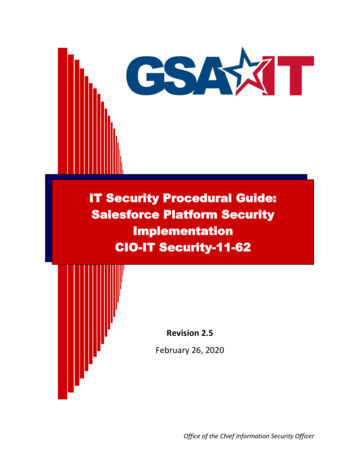
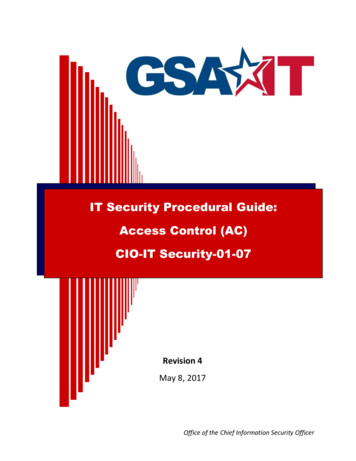
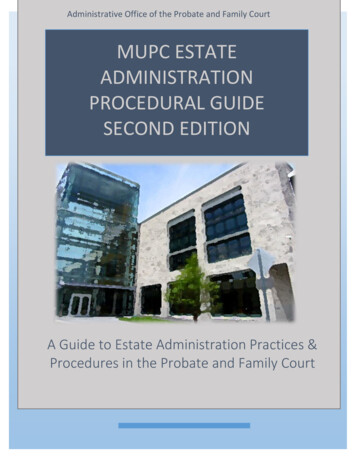
![IT Security Awareness and Role Based Training Program [CIO-IT Security]](/img/15/it-20security-and-privacy-awareness-and-role-based-training-program-5bcio-it-security-05-29-rev-6-5.jpg)
